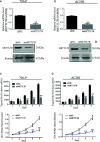Downregulation of METTL7B Inhibits Proliferation of Human Clear Cell Renal Cancer Cells In Vivo and In Vitro
- PMID: 33718220
- PMCID: PMC7952878
- DOI: 10.3389/fonc.2021.634542
Downregulation of METTL7B Inhibits Proliferation of Human Clear Cell Renal Cancer Cells In Vivo and In Vitro
Abstract
Clear cell renal cell carcinoma (ccRCC) is the most aggressive urologic tumor, and its incidence and diagonosis have been continuously increasing. Identifying novel molecular biomarker for inhibiting the progression of ccRCC will facilitate developing new treatment strategies. Although methyltransferase-like 7B (METTL7B) was identified as a Golgi-associated methyltransferase, the function and mechanism of METTL7B in ccRCC development and progression has not been explored. METTL7B expression were significantly upregulated in ccRCC tissues (n = 60), which significantly associated with TNM classification, tumor size, lymph node metastasis, and poor prognosis for ccRCC patients. Functional studies showed downregulation of METTL7B inhibited cell proliferation, migration in vitro, and xenograft tumor formation in vivo. In addition, METTL7B knockdown promoted cell cycle arrest at G0/G1phase and induced cellular apoptosis. Taken together, downregulation of METTL7B inhibits ccRCC cell proliferation and tumorigenesis in vivo and in vitro. These findings provide a rationale for using METTL7B as a potential therapeutic target in ccRCC patients.
Keywords: METTL7B; ccRCC; methyltransferase; proliferation; tumorigenesis.
Copyright © 2021 Li, Xu, Peng, Zhang, He, Chen, Chen, Fan and Wang.
Conflict of interest statement
The authors declare that the research was conducted in the absence of any commercial or financial relationships that could be construed as a potential conflict of interest.
Figures








Similar articles
-
Methyltransferase-like 7B participates in bladder cancer via ACSL3 m6A modification in a ferroptosis manner.Biol Direct. 2025 Jan 20;20(1):9. doi: 10.1186/s13062-025-00597-z. Biol Direct. 2025. PMID: 39833962 Free PMC article.
-
METTL7B Is Required for Cancer Cell Proliferation and Tumorigenesis in Non-Small Cell Lung Cancer.Front Pharmacol. 2020 Feb 28;11:178. doi: 10.3389/fphar.2020.00178. eCollection 2020. Front Pharmacol. 2020. PMID: 32180726 Free PMC article.
-
METTL7B (methyltransferase-like 7B) identification as a novel biomarker for lung adenocarcinoma.Ann Transl Med. 2020 Sep;8(18):1130. doi: 10.21037/atm-20-4574. Ann Transl Med. 2020. PMID: 33240979 Free PMC article.
-
Long Non-Coding RNA LUCAT1 Promotes Proliferation and Invasion in Clear Cell Renal Cell Carcinoma Through AKT/GSK-3β Signaling Pathway.Cell Physiol Biochem. 2018;48(3):891-904. doi: 10.1159/000491957. Epub 2018 Jul 20. Cell Physiol Biochem. 2018. PMID: 30032137
-
Defining the elusive oncogenic role of the methyltransferase TMT1B.Front Oncol. 2023 Jun 29;13:1211540. doi: 10.3389/fonc.2023.1211540. eCollection 2023. Front Oncol. 2023. PMID: 37456227 Free PMC article. Review.
Cited by
-
METTLing in Stem Cell and Cancer Biology.Stem Cell Rev Rep. 2023 Jan;19(1):76-91. doi: 10.1007/s12015-022-10444-7. Epub 2022 Sep 12. Stem Cell Rev Rep. 2023. PMID: 36094754 Free PMC article. Review.
-
LncRNA ZNF674-AS1 Hinders Proliferation and Invasion of Hepatic Carcinoma Cells through the Glycolysis Pathway.J Oncol. 2022 Jul 13;2022:8063382. doi: 10.1155/2022/8063382. eCollection 2022. J Oncol. 2022. PMID: 35874626 Free PMC article.
-
Methyltransferase-like 7B participates in bladder cancer via ACSL3 m6A modification in a ferroptosis manner.Biol Direct. 2025 Jan 20;20(1):9. doi: 10.1186/s13062-025-00597-z. Biol Direct. 2025. PMID: 39833962 Free PMC article.
-
Overexpression of LINC00936 Inhibits the Proliferation and Invasion of Endometrial Carcinoma Cells.J Oncol. 2022 May 31;2022:2223954. doi: 10.1155/2022/2223954. eCollection 2022. J Oncol. 2022. PMID: 35685427 Free PMC article.
-
Characterization of METTL7B to Evaluate TME and Predict Prognosis by Integrative Analysis of Multi-Omics Data in Glioma.Front Mol Biosci. 2021 Sep 17;8:727481. doi: 10.3389/fmolb.2021.727481. eCollection 2021. Front Mol Biosci. 2021. PMID: 34604305 Free PMC article.
References
LinkOut - more resources
Full Text Sources
Other Literature Sources

